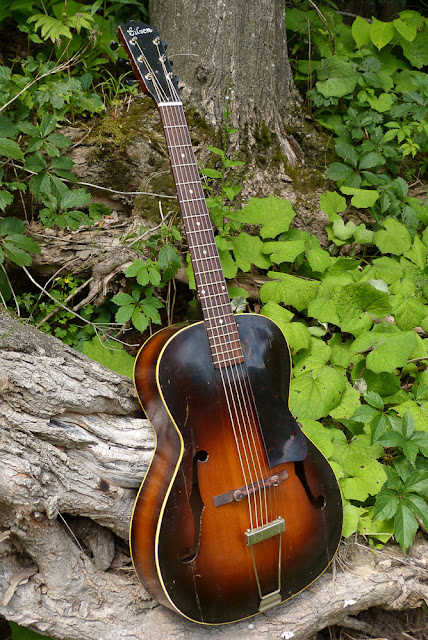1941 Gibson L-30 Carved-top Archtop Guitar
Who doesn't love old Gibson carved-tops? This one came late in the game for the L-30 model and has a factory order number that places it at 1941. Hello, war! At any rate, these L-30s are pretty hip creations with the famous "L-00" body shape and sporting a carved (rather than pressed) top and flat back. With 3 1/2" side depth and the tight-waisted, sexy shape, these handle extremely easily and "fit like a glove" in the lap.
Like I said, the top is carved solid spruce and the back and sides are solid maple (plain Jane, though). The neck is a medium C-profile mahogany number with a Brazilian rosewood board. I really like 40s Gibsons because (more or less) right after the late 30s batches they went to a C-shaped neck that's much more comfortable for the average player. This neck is even a little bit thinner front/back than your average 40s Gibson and it really feels more like a mid-late 50s one on the left hand. I was pleasantly surprised at that!
The guitar is original save for a new bridge, replacement tuners/ferrules, and a new bone nut. The original tuners come with the guitar but aren't in a fit state for use (they're a little slack, too). The finish looks like it had a bit of something brushed on just near the fretboard extension -- I'm guessing to cover-up pickwear. I see that a lot on these guys and it's not a distraction at all.
My work on this included repairing and cleating up 3 top hairline cracks (you can see them easily in this pic) as well as regluing a seam separation/side crack area at the bass-side waist. Two of the back braces also had their wings glued-up. After that came a total refret with thinner medium stock (a super-nice upgrade and necessary as this had been played down to the wood on the frets!), the new bone nut, fitting of a new rosewood bridge, parts-bin older Kluson tuners machines install, and a general cleaning and setup.
She plays like a dream and the truss rod works perfectly. This plays like a brand-new boutique instrument with all the lovely charm of an oldy. I can't overestimate the impact of a carved-top vs. a pressed-top Gibson -- especially in the high-end and overall "punch" of the guitar. This guitar's closest relative -- the Kalamazoo KG-21 -- sounds excellent and generally has a good, thumpy mids sound... but this L-30 is like one of those guitars but on steroids: the higher you play up the neck the more snap, zing, and clarity you get for lead work.
I know the split-shaft tuners aren't a perfect match, but they sure do keep those string-ends nice and tidy (and there was an early Kluson Safe-T-String split-shaft tuner that was in use at the time).
This has a 1 11/16" nut width and radiused board. The strings are GHS 54w-12 "vintage bronze" and, considering the tailpiece setup and shorter 24 3/4" scale, this guitar has almost an "electric" feel to its ease-of-play.
Board looks great -- with the exception of mild wear here and there -- and the pearl dots are bright and shiny. I really love the feel of the new frets, too.
I managed to procure a nice "long foot" rosewood bridge for replacement of the original. Intonation is excellent and this is adjustable up and down to set action however one would like. The "long foot" is fit to the top so it makes contact over the whole bridge length. This is a very stable approach and typical of Gibsons from the period but not at all typical for newer guitars.
The tail is original but curious in that it's not the heavier-duty standard used on most Gibsons from the time. It seems to be a transitional unit.
The flat maple back has one tiny 2" hairline at the bass waist area but is otherwise unmolested.
The neck angle is perfect. This strap button came with the guitar and so I put it back on after work. Why not?
These L-00-size archtops sure are lookers, aren't they?
Here's that repaired/stable hairline crack on the bass side.
These original Kluson tuners come with the guitar.





















Comments
info to my email
israel.cok1@gmail.com